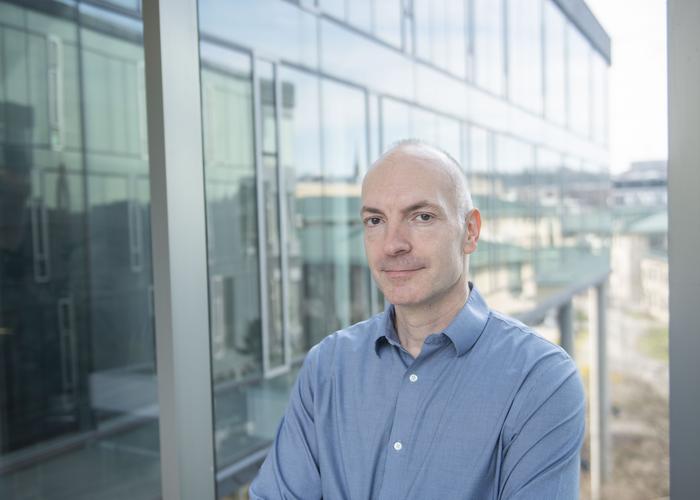Software is ubiquitous in everyday life, but that hasn’t always been the case. Just 25 years ago, cellphones came with Snake installed, Apple released its clamshell design iBook and LiveJournal hit the internet. That same year, 1999, Carnegie Mellon University’s School of Computer Science founded the Institute for Software Research (ISR).

Credit: Carnegie Mellon University
Software is ubiquitous in everyday life, but that hasn’t always been the case. Just 25 years ago, cellphones came with Snake installed, Apple released its clamshell design iBook and LiveJournal hit the internet. That same year, 1999, Carnegie Mellon University’s School of Computer Science founded the Institute for Software Research (ISR).
So much has changed since then. Apple sells smartphones that can download any game — including Snake — and blogging is now mostly vlogging. At CMU, ISR is now the Software and Societal Systems Department (S3D), with 57 core faculty members and two Ph.D. programs.
Nicolas Christin is thrilled to be at the center of it all as S3D’s new department head.
“This department is at the interface of computer science and real-world impact. As a department head, you have to know everything that’s going on,” said Christin, who will start his new role on September 1. “All the work I hear about is super cool and exciting. I’m like a kid in a candy store.”
Christin joked that his security research might not have been housed in S3D when the department was initially founded two decades ago because his work looks at how software impacts society. Now, S3D has academics working on security, concurrent computation, software engineering, game theory, policy and more. For the last 15 years, Christin’s work has focused on measuring and analyzing phenomena on the internet, such as the distribution of drugs online or cryptocurrencies, and providing this data to policymakers who can enact change.
“As computer scientists, we know how to capture data and we know how to analyze that data,” Christin said. “Ultimately, from this measurement and analysis, you can answer questions like, ‘Every year, how many millions or billions of dollars go through the internet to buy and sell narcotics?’ And that’s interesting to whom? Well, to pretty much everybody, and in particular to policymakers. The U.S. Congress and the European Parliament, for instance, want to understand if they can intervene and what the best intervention would be.”
Christin joined CMU in 2005 as a systems scientist. He became an assistant research professor in 2013 and, most recently, a professor in S3D with a joint appointment in the Department of Engineering and Public Policy and a courtesy appointment in the Electrical and Computer Engineering Department. He’s a core faculty member of CyLab, CMU’s security and privacy research institute, and the director of S3D’s Societal Computing Ph.D. program. Before coming to Pittsburgh, he was a post-doctoral fellow at the University of California, Berkeley, and earned his Ph.D. in computer science from the University of Virginia.
Christin succeeds James Herbsleb, who was appointed in 2019 and shepherded the department through its rebranding from ISR to S3D, managed changes during COVID-19 shutdowns and oversaw an expansion in programs.
SCS Dean Martial Hebert said he was excited for Christin to step into this role.
“I want to thank Nicolas for taking on this responsibility,” Hebert said. “I know that his energy and research leadership will be instrumental in leading S3D.”
Christian Kästner, an associate professor and director of the Software Engineering Ph.D. program, led the search committee for the position. He said the committee was looking for someone who understood the department’s breadth, would lead it fairly and could engage with all the stakeholders.
“We wanted someone who understands the two Ph.D. programs and is committed to the department,” Kästner said.
As the director of the Societal Computing Ph.D. program, Christin says he’s seen firsthand how the breadth of the research and work in software has changed within S3D. As the department head, he will focus on sustainably managing the department’s growth and ensuring that faculty, staff and students are involved in S3D’s direction.
“I think this is one of the defining characteristics of our faculties, that people are curious — not just intellectually curious about their own domain, but intellectually curious about stuff that they don’t know much about,” Christin said. “This helps foster and nurture dialogue between the various department constituencies. One of the big challenges will be to make sure that this intellectual objective translates into more integration between the department’s various lines of research.”
Over the next few years, Christin wants to spearhead initiatives that bring advanced courses to undergraduates. He said students should have access to classes that reflect the diversity of disciplines interfacing with computer science, such as privacy, ethics and network science.
“I hope that we can enrich the computer science curriculum by providing some offerings that migrate a bit from the Ph.D. level to an undergraduate level,” he said. “This is often what happens in science: you get some field of study that is brand new and super advanced, and you need a master’s or a Ph.D. to understand it. As time goes by, the discipline matures, and you understand better what you’re doing. At that point, it’s possible to translate topics in the field and disseminate them to more junior students. That’s what I’m hoping for in S3D.”



